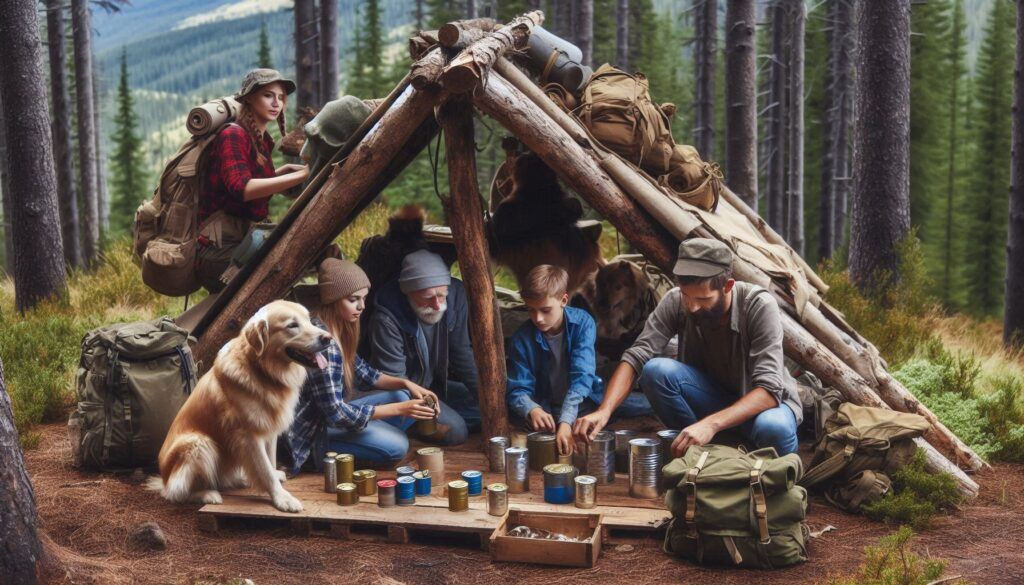 Survival in the wild isn’t solely about having sharp skills or being able to hunt and gather food. One of the cornerstones of wilderness survival is knowing how to build a shelter. In a sticky situation, knowing how to build survival shelters in the wilderness can make the difference between life and death.
Survival in the wild isn’t solely about having sharp skills or being able to hunt and gather food. One of the cornerstones of wilderness survival is knowing how to build a shelter. In a sticky situation, knowing how to build survival shelters in the wilderness can make the difference between life and death.
A well-constructed shelter shields you from gnarly weather—be it cold, rain, or scorching sun. It keeps you safe from nocturnal creatures looking for a midnight snack and helps maintain your body temperature. Hypothermia isn’t something to take lightly, and the right shelter can be your frontline defense in preventing it. Pack compact mylar blankets or ponchos as well.
Learning to build an outdoor survival shelter isn’t just about stacking sticks in a certain way. It requires an understanding of your environment, available materials, and kind of weather you might encounter. Grasping these basics means you’ll have a better chance of creating something functional and enduring.
There’ve been countless stories of hikers and adventurers who managed to survive treacherous conditions thanks to their knowledge of shelter building. Knowing your stuff means you’re prepared not just for a planned camping trip, but for unforeseen disasters too. Being a pro at this can give you some serious peace of mind when you’re out there in the great unknown. More importantly, your loved ones will sleep a little easier knowing you can handle yourself.
10 Wilderness Survival Shelter Designs
Knowledge about different shelter designs is crucial when you’re forced to survive in the wilderness. Each design comes with its unique perks and challenges. Here’s a look at ten shelters that can keep you safe and sound.
1. **Lean-To Shelter**: A classic and easy design, perfect for beginners. You’ll need a long branch to lean against a tree or a large rock, then add smaller sticks and branches to create a slanted roof. Cover it with leaves, moss, or any material available for insulation.
2. **Debris Hut**: This one’s more insulated and is excellent for colder climates. Form a sturdy frame with sticks, and pile leaves, grass, and debris around it for warmth. It’s like nature’s very own cozy sleeping bag.
3. **Tarp Shelter**: Got a tarp? Awesome! With a little rope and some trees, you can set up a shelter quickly. Perfect for protection against rain, it’s lightweight and very portable. A must-know for any adventurer with minimal gear.
4. **Snow Cave**: In snowy landscapes, snow caves can be real lifesavers. Dig into a snowbank to create a small cave. The snow itself acts as insulation, keeping the interior surprisingly warm.
5. **Quinzhee**: Like a snow cave but made from a pile of snow that you compact and then hollow out. This is fantastic for longer-term shelter in snowy conditions, though it takes a bit more time and effort.

6. **A-Frame Shelter**: Your traditional tent-like structure. Easy to build with branches and cover with leaves, moss, or a tarp. Great for shedding rain and wind, making it versatile for various weather conditions.
7. **Wickiup**: Inspired by Native American design, this involves a simple frame of sticks arranged in a tepee shape and covered with brush, leaves, or even animal skins. It’s sturdy and can withstand heavier weather.
8. **Bough Bed Shelter**: A frame made from sturdy branches, with a bed of boughs inside to keep you off the cold ground. Add a roof of more branches and foliage. This one’s a bit more complex but super comfortable.
9. **Rock Shelter**: Use natural rock formations as the foundation of your shelter. Find a rocky overhang and build up walls with stones and branches. Nature’s own little fortress.
10. **Tree Pit Shelter**: If you’re in a densely forested area, dig a pit at the base of a sturdy tree, line it with leaves and branches, and use more branches to create a roof. It’s stealthy and provides good insulation.
Building Long-term Survival Shelter
When you’re looking to settle in the wilderness for an extended period, a long-term shelter becomes essential. These shelters need to be stronger, weather-resistant, and comfortable. Here’s what you need to know to get started. Hopefully you were also able to pack some survival tools.
First, consider the location. Select a spot that’s elevated to avoid flooding and close to resources like water and firewood. The site should also offer natural protection against wind and predators.
Gathering materials is crucial. You’ll need sturdy, long-lasting materials like large branches, logs, stones, and plenty of insulating foliage. A strong frame is the backbone of any long-term shelter, so ensure the structural integrity is high.
Building a Log Cabin-Style Shelter

One of the best options for long-term survival is the log cabin-style shelter. It’s labor-intensive, but its durability and insulation are top-notch. Start by selecting straight, sturdy logs and stack them in a crisscross fashion to create the walls. Use mud or clay to seal gaps between logs for additional insulation.
The roof is another critical component. A sloped, thatched roof will effectively keep out rain and snow. Cover it with thick foliage or thatch for a waterproof seal. Inside, consider a raised bed to stay off the cold ground and add extra insulation from leaves or grass for comfort.
Building an Earth Shelter
Earth shelters are another solid option for long-term stays. Dig a pit and use the excavated soil to build up walls around the perimeter. Incorporate logs or wooden planks to reinforce the structure and prevent collapse. The earth provides excellent natural insulation against extreme temperatures.
The roof can be constructed similarly to the walls but will require stronger supports to handle the weight of any layers added on top. A watertight cover is crucial, so tarps, thick thatch, or even a sod roof can work. Inside, a fire pit and proper ventilation are essential to maintain warmth and air quality.
Maintenance is key for all long-term wilderness survival shelters. Regularly check for wear and tear, reinforce structures as needed, and adapt based on changing weather conditions. Long-term shelters require continual care, but they offer unmatched protection and comfort when built correctly.
Conclusion: Mastering Shelter Building Skills for Wilderness Survival
The ability to build a functional shelter in the wild isn’t just a handy skill. It’s a critical piece of your survival toolkit. From the quick Lean-To to the sturdier Log Cabin, each shelter design offers unique benefits tailored to different situations and environments.
Getting familiar with a variety of wilderness survival shelter designs prepares you for unexpected scenarios. Whether you’re dealing with cold climates, heavy rain, or just need a simple shade from the sun, knowing what type of shelter to construct—and how—could be a game-changer. You could even take a look on how to build one of those tiny homes.
Long-term shelter building takes more time and effort but pays off with increased comfort and safety. It’s a good idea to practice constructing these shelters occasionally, so you’re ready when you need these skills the most. Regular practice helps build confidence and efficiency.
Remember, preparation is key. Pack necessary tools, study different designs, and understand your environment before heading out. The peace of mind of knowing how to build survival shelters in the wilderness is priceless. Stay alert, stay educated, and most importantly, stay safe in the wilderness.
___________________________________________________________________________________________________
(I may earn a commission if you click on certain links on this website)

This is an amazing website. I think we are about to head into a real shite storm and we a ll need to be prepared. Unfortunately not many will be. and, terrible as it sounds, the people who do not prepare will not survive.
when you see governments around the world (and close to home) actively allowing poison to be taken by its own countrymen and women, you know the world is going down the “tubes”
Even if it does not happen at least the knowledge you and others provide will be passed onto others.
I grew up in New Zealand and had a ‘sort of” outdoor life. In other words, my dad taught me how to fish and my friends taught me how to shoot, skin animals etc. Sadly lacking in today’s generation.
the other thing I would like you to write about is how we can use computers after a “catastrophe”. There must be a way you could put up a basic network to access info. and other people in the worst-case scenario.
Great Site
Steve
Thank you for your comments, Steve. I agree that the future is delicate, and that we are being poisoned. I am glad to hear that you have some wilderness survival skills. People must at least have food, water, and supplies set aside for disaster scenarios. Many people around the world have suffered, even if they have prepared. We can’t trust FEMA, Red Cross, or any Govt organization to help us. We must be ready to help ourselves, and others as we are able.
That is a good suggestion you have about accessing computer information after a disaster. Part of that is preserving laptops, cell phones, and other electronics in faraday bags in the event of an EMP or other catastrophe that could affect electronics. We need battery, solar and hand crank radios to access info, walkie talkies instead of cell phones, etc. But I would have to research accessing the computer after a disaster that affected the internet.
Sincerely, Jeffrey G
This article is a valuable resource for anyone interested in survival skills and preparedness. It covers essential techniques for building different types of shelters in the wilderness, from lean-tos to debris huts, ensuring readers can adapt to various conditions and environments. The step-by-step instructions and tips on materials, location selection, and insulation make it practical and accessible, even for beginners. It’s a must-read for outdoor enthusiasts, campers, or anyone wanting to gain confidence in their survival skills.
Thank you for your comments, Marc. Most of us don’t want to be in that situation, but I hoped to provide some kind of starting point for people, just in case. Disasters seem to be hitting left and right these days. Jeff
This is very valuable information to know and I had no idea that basic things out of nature could keep you insulated and protect you from hypothermia.
Most of the structures seem to be triangular in shape. Is this because this shape is easier to put together?
I think everyone should have a basic knowledge on how to survive in the wilds, and building a shelter is just one aspect. You never know when you will need to know how to do this.
Yet again another great article from you. Thanks so much for sharing. Knowing how to build a survival shelter is a crucial skill for wilderness survival. A well-constructed shelter can protect against the elements, predators, and hypothermia. The type of shelter depends on the environment and available materials. From simple lean-tos to more complex structures like log cabins and earth shelters, each design offers unique benefits. Practice and knowledge are key to building effective shelters, ensuring your safety and comfort in the wilderness.
Hi Kris, yeah, it’s easier said the done. But it is important to recognize that we could be in that predicament some day, just like so many in WNC have surely had to face. Jeff